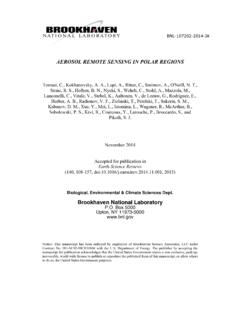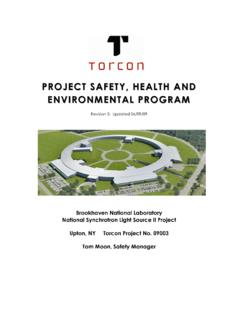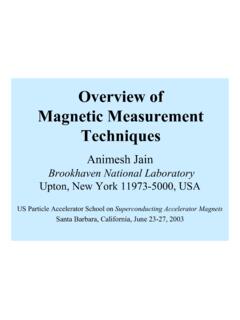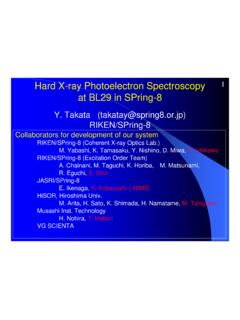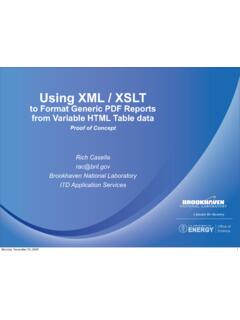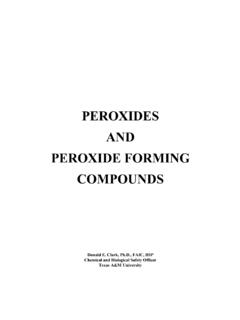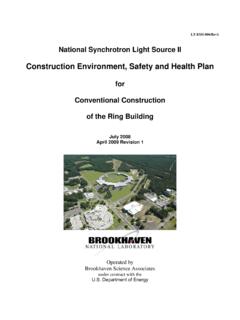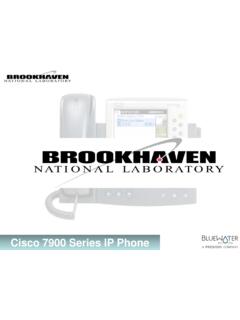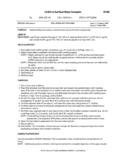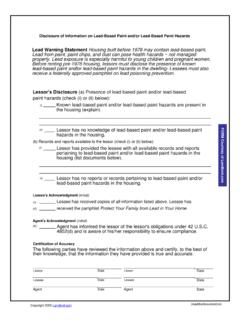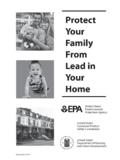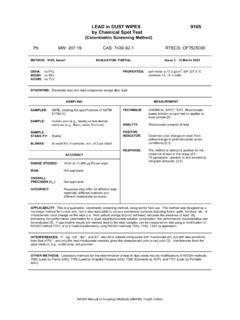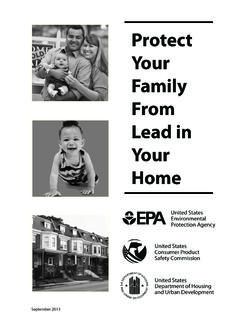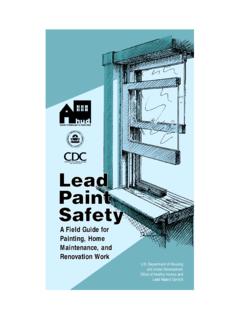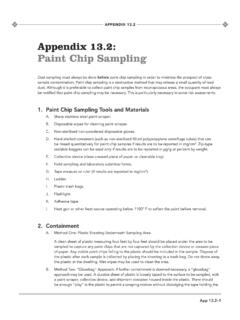Transcription of IH75190 Surface Wipe Sampling for Metals
1 The only official copy is on-line at the SHSD website. Before using a printed copy, verify that it is current by checking the document issue date on the website. BROOKHAVEN NATIONAL LABORATORY Safety & Health Services Division - Industrial Hygiene Group Standard Operating Procedure Number IH75190 Revision Rev23 Subject: Surface wipe Sampling for Metals Date 06/23/17 Page 1 OF 16 IH75190 Surface wipe Sampling for Metals Purpose & Scope This document describes a field procedure for taking wipe samples for Metals on surfaces . It is based on methodology described in NIOSH 9100 Lead in Surface wipe Samples of the NIOSH Manual of Analytical Methods.
2 The goal of the procedure is to provide a uniform methodology to collect representative samples. Using this method will ensure repeatability between various Sampling personnel and between Surface configurations. It is used for characterizing Surface levels for the following reasons: o Decommissioning operational areas o Evaluating the effectiveness of clean-up of a spill o Evaluating compliance with housekeeping levels in operational areas o Characterizing a piece of equipment for release. Responsibilities Demonstrated Competency: This procedure is administered through persons who have demonstrated competency in performing this procedure in accordance with Section 7 are qualified to use this procedure.
3 Chain of Custody procedures: The qualified sampler is responsible for samples until they have been properly transferred to the IH Group laboratory using the IH51200 IH Laboratory Equipment & Sample Processing procedure. Hazard Analysis of the Sampling Task: It is the responsibility of persons using this method and their supervisors to: Use appropriate personal protective equipment; s ee section Obtain required training and qualification for hazards in areas. Comply with all work planning and work permit system requirements. Definitions Surface wipe - a technique for the determination of metal on surfaces conducted by wiping the loose dust from the Surface with a cloth/paper media and analysis of the metal on the media by laboratory or XRF measurement.
4 Definitions associated with Surface wipe criteria are cited in Attachment Prerequisites Area Access: Training for hazards may be needed for entry into areas with hazards, such as radiological The only official copy is on-line at the SHSD website. Before using a printed copy, verify that it is current by checking the document issue date on the website. BROOKHAVEN NATIONAL LABORATORY Safety & Health Services Division - Industrial Hygiene Group Standard Operating Procedure Number IH75190 Revision Rev23 Subject: Surface wipe Sampling for Metals Date 06/23/17 Page 2 OF 16 Contact the appropriate Facility Support Representative or Technician to obtain approval to enter radiological areas.
5 Review and sign the Work Permit or Radiological Work Permit if needed. Use appropriate PPE for area. Precautions Hazard assessment: Taking Surface wipe samples may cause some exposure to health risks. Sampling may be performed in areas with metal, chemical or radiological contamination. These hazards must be assessed on a case-by-case basis by a competent individual knowledgeable of the hazards of the area. Job Risk Assessment: Consult the Job Risk Assessment SHSD-JRA-05 for the risk analysis of this operation based on the hazards and controls of this SOP. Personal Protective Equipment: Use appropriate personal protective equipment when implementing this procedure.
6 Hand: Use gloves in areas of known or suspected metal, chemical or radiological contamination. Exam-style, splash gloves are acceptable. Acceptable polymers are: Nitrile, PVC, and Natural Rubber. The gloves must have sufficient impermeability to the Surface contaminant and solvent used on the collection media to allow safe handling. See Table 1. Body: Use a disposable suit if contact of the body with contaminated surfaces is anticipated. Acceptable chemical protective equipment materials include: Tyvek , KleenGuard , and cotton. Contact the ECR for disposable of garments. If personal clothing items become contaminated, they must be surrender for BNL cleaning or disposal.
7 Foot: Use disposable shoe coverings, boots or booties if contact of the feet with contaminated surfaces is anticipated. Acceptable material include: Tyvek , KleenGuard , and rubber. If personal shoes become contaminated, they must be surrendered for BNL cleaning or disposal. Respiratory: Under normal use, respiratory protection is not required. Use a respirator in an area with the potential to exceed the OSHA, ACGIH, or DOE standards. The person collecting using respiratory protection must comply with the BNL Respiratory Protection Program. Eye: Use safety glasses with side shields in laboratories, construction, and general industry areas.
8 Radioactive Concerns: It is possible that some surfaces to be tested may have radioactive contamination. In these cases, personal protective equipment and administrative controls must be implemented for the radiological contaminant hazard. In addition, the collected sample must be analyzed for the radiological hazard before it can be submitted to the IH Group for analysis. The radiological contamination must be below the permissible release limits to the general public. Work Planning: All requirements of work permits and work planning system reviews must be met in performing this procedure.
9 Personal Hygiene: Remove PPE and wash hands after Sampling and before eating or drinking. The only official copy is on-line at the SHSD website. Before using a printed copy, verify that it is current by checking the document issue date on the website. BROOKHAVEN NATIONAL LABORATORY Safety & Health Services Division - Industrial Hygiene Group Standard Operating Procedure Number IH75190 Revision Rev23 Subject: Surface wipe Sampling for Metals Date 06/23/17 Page 3 OF 16 Environmental Impact and Waste Disposal: This technique does not have adverse impact on the environment. Based on WMD testing of similar PPE material, the templates and gloves can be disposed as normal trash.
10 See Attachment Procedure Equipment Sample container (either): Bag, plastic, sealable with zip type seal. Vial, glass or plastic. (Glass is needed for hexane solvents based samples). Sample media (any of these): Gauze: 2 x 2 or 4 x 4 cotton gauze Paper: Ashless quantitative filter paper (typical diameter is to 4 inches) Pre-moistened wipe : manufacturer foil wrapped, solvent soaked disposable cloths (such as GhostWipes or LeadWipe The type of wipe is dependent on the lab to be used. Check with the lab for appropriate media for the Metals to be analyzed. For multiple Metals , check with the lab to ensure they can all be done on a single wipe Gloves Appropriate for contaminant and solvent (see Table 1) and site hazards.)
